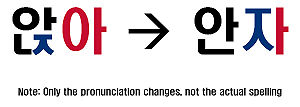받침
The 받침 is the final consonant(or consonant cluster) at the end of a Korean syllable. The 받침 is written in the bottom/final position. Conjugation rules will often depend on if there is a 받침 or not. The consonant in the 받침 position is said to be in the "final position."
The jamo (units that make up the Hangul alphabet) sound may also differ from it's original sound if not followed by a vowel.
Contents
Pronunciation: Consonant Followed By a Vowel
if a consonant in the final position followed by a vowel, the sound shifts over. The only sounds that doesn't shift over to the next syllable is ㅇ since it is weird to begin a weird with a "ng" sound and ㅎ becomes silent when followed by a vowel. Also when ㅌ is in the final position and followed by the vowel 이, the sound becomes 치. See ㅌ + 이.
| Original | Actual Pronunciation |
|---|---|
| 맞아 | 마자 |
| 먹어 | 머거 |
| 집에 | 지베 |
| 좋아 | 조아 |
| 놀아 | 노라 |
| 필요하다 | 피료 |
| 한국어 | 한구거 |
| 같이 | 가치 |
| 졸업 | 조럽 |
| 십일 | 시빌 |
Pronunciation: Consonant Not Followed By a Vowel
If a consonant in the final position and it is not followed by a vowel, meaning it is the last syllable of the word or followed by another consonant, then it may have a different pronunciation. Notice from the table below that many characters share the same sound when in the 받침 position.
| Letter(s) | Pronunciation | Comment | Examples | Audio |
|---|---|---|---|---|
| ㄱ,ㄲ,ㅋ | /k/ | The /k/ sound is cut short. | 먹다 부엌 깎다 |
Error: file |
| ㅂ,ㅍ | /p/ | The /p/ sound is cut short. | 밥 수업 춥다 높다 가고싶다 |
Error: file |
| ㄹ | /l/ sound | If ㄹ is followed by a vowel it is a /r/ sound | 말 살 칼 잘 팔다 멀다 알다 |
Error: file |
| ㅇ | /ŋ/ sound | Normally ㅇ acts as a placeholder for a consonant and makes no sound, only in the final position does it make a sound. | 강 성 왕 콩 선생 |
Error: file |
| ㄷ, ㄸ,ㅈ,ㅅ,ㅆ,ㅌ,ㅊ | /t/ sound | 옷 곧 찾다 있다 같다 꽃 |
Error: file |
Note: ㅃ and ㅉ can't appear in the final position.
Consonant Assimilation
When certain consonant sounds meet each other, there are consonant assimilation rules that modify the standard pronunciation. For a complete set of rules, see the consonant assimilation section.
| Word | Actual Pronunciation | Consonant Assimilation Rule |
|---|---|---|
| 원래 (Originally) | 월래 | ㄴ + ㄹ → ㄹ, ㄹ |
| 작년 (Last year) | 장년 | ㄱ + ㄴ → ㅇ, ㄴ |
| 대학로 (An area in Seoul) | 대항노 | ㄱ + ㄹ → ㅇ, ㄴ |
| 종로 (Jogno, an area in Seoul) | 종노 | ㅇ + ㄹ → ㅇ, ㄴ |
| 열한 (Eleven) | 여란 | ㄹ + ㅎ → ㄹ |
| 행복하다 (To be happy) | 행복카다 | ㄱ + ㅎ → ㅋ |
| 입학 (School admission) | 이팍 | ㅂ + ㅎ → ㅍ |
| 그헣지 (That's right) | 그러치 | ㅎ + ㅈ → ㅊ |
| need ㄷ example | 그러치 | ㄷ + ㅎ → ㅌ |
Double 받침
It is possible to have two different consonants in the final syllable position (a consonant cluster). If the next syllable starts with a vowel, the sound in the second 받침 position will shift to the next syllable unless it is an ㅎ, in which case the sound is simply ignored.
| Original | Actual Pronunciation |
|---|---|
| 얽어 | 일거 |
| 없어 | 업서 |
| 앉아 | 안자 |
| 짧아 | 짤바 |
| 싫어 | 실어 → 시러 |
| 괜찮아 | 괜찬아 → 괜차나 |
However if it is followed by a consonant in the next syllable over, there is no specific rule as to which sound to pronounce; you must memorize the words individually. The second consonant in the 받침 can also affect the next syllable if one of the consonant assimilation rules applies. See the picture example.
Also add: 잃다,닳다, 귀찮아, 끊다, 끓다 젊다, 읽히다 개미핥기,수박 겉 핥기
- <TODO: insert table> List of words where the first consonant gets pronounced
- 많다
- 않다
- 돐
- 넋
- 앉다
- 짧다
- 없다
- 핥다
- 싫다
- 괜찮다
- 여덟
ㄵ,ㄶ, ㄳ, ㄼ, ㅀ,
pattern with the specific 받침?
ㄺ,ㄻ, ㄺ,ㄿ,
- <TODO: insert table> List of words where the second consonant gets pronounced
- 삶
- 닭
- 굵다
- 옮다
- 굶다
Please note the tensed consonants(ㅃ, ㅉ, ㄸ, ㄲ, ㅆ,) can appear in the 받침 position, but this doesn't make it a double 받침 since it is still one character and not two separate characters.
Exceptions
Words like 닭(chicken) when followed by the subject marker 이 and the object marker 을 would normally have the pronunciation "달기" and "달글" respectively if they followed the normal rules. However they get pronounced as "다기" and "다글" instead.

